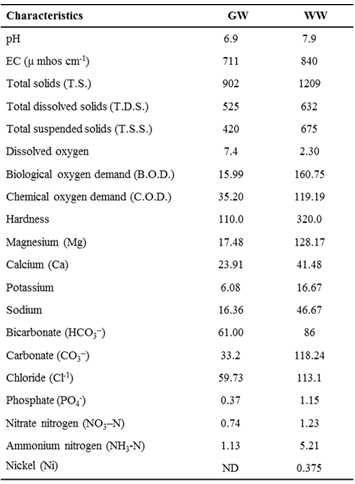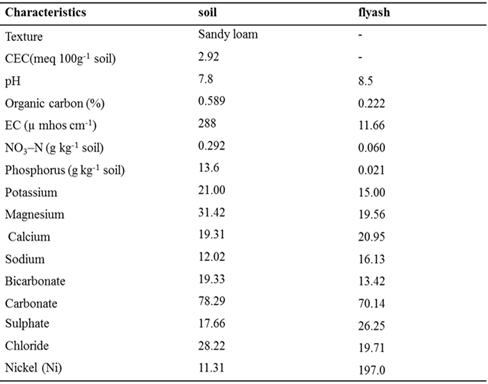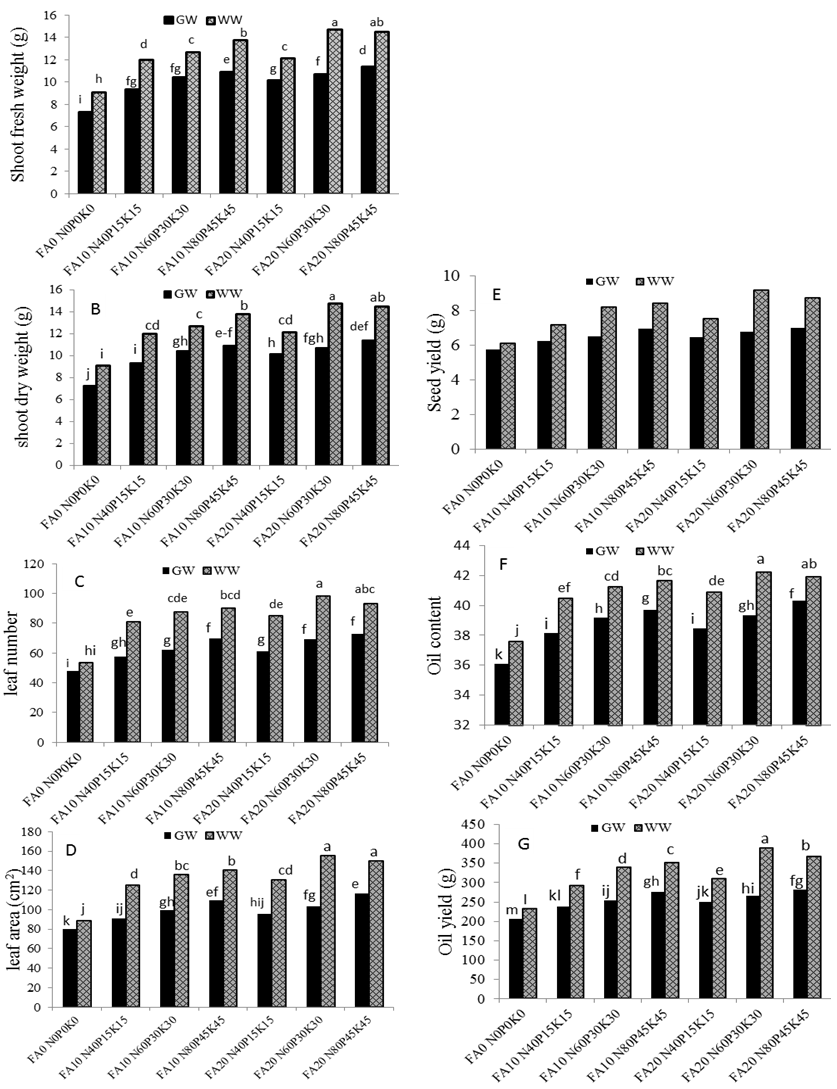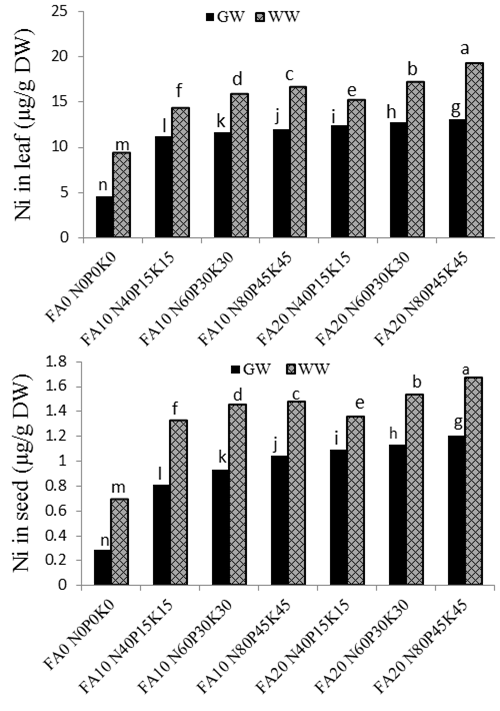-
Paper Information
- Next Paper
- Previous Paper
- Paper Submission
-
Journal Information
- About This Journal
- Editorial Board
- Current Issue
- Archive
- Author Guidelines
- Contact Us
Resources and Environment
p-ISSN: 2163-2618 e-ISSN: 2163-2634
2014; 4(1): 25-33
doi:10.5923/j.re.20140401.03
Enhancement of Biomass and Yield with Ni Uptake and Tolerance of Brassica juncea (cv. Pusa Bold) by Applying Inorganic Fertilizers in Soil Amended with Flyash and Wastewater
Seema Sahay1, Akhtar Inam2, Saba Iqbal1
1Environmental Science & Advance Plant Physiology Section, Aligarh Muslim University, Aligarh, U.P, India, 202002
2Botany Section, Women’s college, Aligarh Muslim University, Aligarh, U.P, India, 202002
Correspondence to: Seema Sahay, Environmental Science & Advance Plant Physiology Section, Aligarh Muslim University, Aligarh, U.P, India, 202002.
| Email: |  |
Copyright © 2012 Scientific & Academic Publishing. All Rights Reserved.
The two waste products, flyash (FA) from thermal power plant and wastewater (WW) generated from urban population has assumed a big and important dimension in many countries including India. Harduaganj thermal power plant is source of flyash in Aligarh, famous for lock and nickel plating industries discharging huge amount of wastewater rich in heavy metals. Today both wastes have become an alternative source of chemical fertilizers for local farmers. In this paper, their utilization is discussed on the basis of results obtained in a pot experiment conducted in Department of Botany, while observing the growth, yield and nickel uptake of Brassica juncea (cv. Pusa Bold). The experiment was run with two levels of FA @ 10 and 20 t ha-1 and three doses of NPK @ 40:15:15, 60:30:30 and 80:45:45 kg ha-1. Results showed that drymatter yield, seed yield and oil content of the crop tested was increased in both FA10WW and FA20WW as compared to crop grown under GW treatments and control having no FA, WW and NPK. The nickel uptake and translocation factor (Tf) showed the successive potential of Ni tolerance of Brassica juncea in soil amended with FA and irrigated with WW. The Tf was higher in FA+WW treatments than FA+GW and control. The overall results indicated that FA20N60P30K30 was found to be most suitable combination with assessment of yield and high oil content as well as Ni accumulation in plant parts. Therefore both wastes may compensate the fertilizers consumption and in addition be an alternative option of waste disposal.
Keywords: Accumulation, Flyash, Wastewater, Indian mustard, NPK, Bioconcentration factor, Transfer factor, Tolerance index
Cite this paper: Seema Sahay, Akhtar Inam, Saba Iqbal, Enhancement of Biomass and Yield with Ni Uptake and Tolerance of Brassica juncea (cv. Pusa Bold) by Applying Inorganic Fertilizers in Soil Amended with Flyash and Wastewater, Resources and Environment, Vol. 4 No. 1, 2014, pp. 25-33. doi: 10.5923/j.re.20140401.03.
Article Outline
1. Introduction
- Agricultural lands practices for wastewater use is a one of the options for dealing with as a way of disposing it, where out of ~30 million tons of wastewater ~70% is consumed as an agricultural fertilizer and irrigation source[1], with data on previously, numerous studies founded that wastewater rich with valuable sources such as organic matter, macro and micro nutrients that required by the plant for fertility and productivity of soil and reduce fertilizer application[2] especially N and P required for ample growth to increase the crop yield[3-6], however high content of N, P and K strengthens its fertigation/ manural value of field crops[7].Flyash (FA) also known as one of the major solid wastes produced as a heterogenous and complex byproduct resulting from coal combustion in thermoelectric power plants (TPPs). The utilization of fly ash instead of dumping it as a waste material can be both on economic and environmental grounds[8]. The application of FA on agricultural land realizes both benefits and negative effect in environment. Like wastewater, disposal of flyash is also a serious environmental problem. Unlike flyash application to agricultural land does not supply crop requirements of essential plant nutrients such as N and P. However the effect of flyash was more prominent and effective for agriculture when used with wastewater application.[9] analyzed the potential of SLASH (a mixture of sewage sludge, lime and flyash (63:1) on the biomass and yield of Triticum and Sorghum spp. which were enhances up to three fold. Therefore, application of two waste products on urban agriculture land throws a major challenge of disposal and management problem of ever increasing amount of both wastes in an environmentally sustainable manner inspite of meet the twin objectives of nutrition and irrigation inexpensively being a critical inputs in agriculture. But it is necessary to model the concentration-uptake-dose-response functions between the amended medium and crop plant. While all these aspects possible only after a proper planning of their safe use and care should be taken because an excess application might be a non-point source of contamination [10]. Presence of high concentration of heavy metals in WW and FA is one of the major limitations for its application on land which might pose heavy metal accumulation in the plant tissues, however some heavy metals such as Fe, Cu, Co, Ni, Mo and Zn are essential for plant growth and development upto a limit.Among oil yielding Brassica species, Brassica juncea has been studied extensively for its tolerance to heavy metals and has been suggested as a good bioremediation of metal contaminated soil[11]. Plants have a range of potential mechanism at the cellular level that might be involved in the detoxification and thus tolerance to heavy metal stress by primarily avoid the build up of toxic concentration at sensitive sites within the cell and preventing the damaging effects. Nickel (Ni) is a major environmental contaminants and one of the wide spread heavy metals, defined as ultra micronutrient. It is considered to be an essential for possibly all plant species[12][13] in small quantity (0.01 to 5 µg g-1 dry wt.), being important component of many enzymes especially urease[14], however, at elevated concentrations of this metal becomes toxic for majority of plant species.The present study deals with the physico-chemical characterization of Aligarh city’s wastewater and flyash and its impact on fresh and drymass yield, seed yield and oil parameters of important locally grown oilseed mustard crop with focused on quantify the level of Ni and their potential to translocation in soil and test crop grown in soil receiving both byproducts.
2. Materials and Methods
2.1. Pot experiment Layout and Treatments Pattern
- Pot experiment was conducted with 7kg soil on Brassica juncea cv. Pusa Bold, during the winter season of 2011-2012 in the net house of Department of Botany, Aligarh Muslim University, Aligarh (27° 52’ N latitude, 78°51’ E longitude at an elevation of 187.45 m above the sea level). The experiment was laid in completely randomized block design. Seeds of Brassica juncea cv. Pusa Bold were procured from IARI (Indian Agriculture Research Institute), New Delhi, India and disinfected with 0.01% aqueous solution of mercuric chloride followed by repeated washing with double distilled water and then dried in shade before sowing. Seeds were sown at the rate of 10/ pot. Every treatment was replicated thrice. After 7 days of sowing (DAS), thinning was done and two plants were left in each pot. Each replicate pot has a set of four pots. In each experiment there were seven treatments with two waters (wastewater and groundwater) and each replicated thrice. Therefore, comparative effect of WW and GW as well as two levels of FA @ 10 and 20 t ha-1 and three levels of NPK as urea, superphosphate and muriate of potash @ 40 kg N ha-1, 15 kg P ha-1 and 15 kg K ha-1, 60 kg N ha-1, 30 kg P ha-1 and 30 kg K ha-1 and 80 kg N ha-1, 45 kg P ha-1 and 45 kg K ha-1, was observed to obtain the suitable combination of inorganic fertilizers, FA and water based on the growth performance Brassica cultivars and their heavy metal extracting capability with biomass production. The results were recorded by the study of shoot fresh and dry weight, leaf number and leaf area, seed yield, oil content and oil yield as well as Ni in leaf at 105 DAS namely fruiting stage and in seed at harvest. All experiments were carried out according to factorial randomized block design. To confirm the variability of data and validity of results, analysis of variance (ANOVA) was conducted. In order to determine whether differences among the treatments within respective DAS were significant as compared to control, Duncan’s Multiple Range test was applied.
2.2. Sampling and Analysis of Water
|
2.3. Sampling and Analysis of Soil and Flyash
- For each experiment soil samples were collected from the pots before sowing which was mixed thoroughly with farmyard manure and analyzed for following physio-chemical parameters. The soil samples were also collected after mixing of flyash and wastewater irrigation at harvesting of crop for the analysis of heavy metals. Flyash was collected from flyash pond of Harduaganj Thermal power plant, Kasimpur located at 14 km away from Aligarh city. In the laboratory, the soil/flyash sample was grinded with the help of mortar and pestle and passed through a 2 mm sieve, oven dried and used for the study of following physio-chemical characteristics of (Table 2). Total heavy metal concentration in soil/flyash before sowing and at harvesting (mg/kg) was determined by the aqua-regia acid digestion method[16].
2.4. Biomass Yield
- The plants were ploughed out at 105 DAS (fruiting stage) and washed by deionized water followed by proper blotting between filter papers. Plants were dried in a hot air oven at 65◦C ± 2◦C for 72 h. The samples were weighed on an electronic top pan balance (KERN Compact Balance EMB, Germany) so as to obtain the biomass accumulation, which was expressed in g plant-1. While yield was recorded at harvest period.
|
2.5. Heavy Metal Analysis
- Dried plant sample then ground and passed through 1mm sieve and were further proceed for analysis of heavy metal concentration (mg/kg dry matter) through acid digestion. 1 g dried plant parts samples were heated with 10 ml of HNO3, H2SO4 and HClO4 mixture in 5:1:1 ratio at 80°C until a clear was obtained[17]. The solution was filtered through Whatman no 42 filter paper and solution was diluted to 100 ml with DDW. The concentration of heavy metals (HMs) in filtrate was determined by using GBS; SenaAA model of double beam atomic absorption spectrophotometer (AAS).Bio-concentration Factor (BCF) and Translocation Factor (TF): The BCF, TF, Ti and EF of HMs were calculated at the time of harvesting according to[18-21] respectively by the following formulas:

3. Results and Discussion
3.1. Biomass and Yield Production of Plant
- Crop yields are generally limited by macro and micronutrients, since these are utilized by crops comparatively in larger quantity. Soil fertility can therefore be maintained by supplying these nutrients as fertilizers through wastewater and flyash. In the present study the GW and WW together with or without flyash along with 3 doses of NPK fertilization has the significant potential in agriculture as soil amendments was taken where WW irrigation and FA when added to soil, was found beneficial for Brassica juncea cv. Pusa bold up to 20 t ha-1 with low dose of NPK. Mean comparison showed that the use of wastewater in comparison with ground water results in increase of growth (Figure A, B, C, D) and yield (Figure E, F, G) of test crop. Similar results were also observed with positive response of various crops in wastewater application by[4] and[22]. The increase of shoot fresh weight, dry weight, leaf number, leaf area, yield and quality attributes of B. juncea cv. Pusa Bold expectedly may be due to availability of the amount of enough macro and micro nutritious elements present in wastewater viz., N, P, K, Ca, Mg, S, Cl etc, and flyash rich in oxides of Ca, B, Si, Al, Mg etc except N and little P[23], along with some heavy metals[24]. These major constituents required by plants for development and metabolic functions and might have played a cumulative role to enhanced growth and photosynthetic capacity which ultimately led to higher pod number, 1000 grain weight and finally the seed yield (Figure E). The ameliorative effect of both wastes is also evident from the result obtained in the present study. Higher values in growth and yield parameters obtained when the nutrient through flyash was supplied at its optimum level. It is, therefore, logical to conclude that FA @ 20 t ha-1 with low dose of NPK (60, 30, 30 kg ha-1 respectively) enhanced the leaf production, leaf area, fresh and dry weight maximum when applied with wastewater, as higher dose fertilizers ( 80, 45 and 45 kg ha-1 NPK) could not enhance them. Present findings also strengthen the earlier findings[25]. The leaf area is the most important because larger green surface area required for photosynthetic activity which ultimately enhanced the seed yield. The leaf area is also dependent upon the supply of sulphur element because it also pointed out that the application of nitrogenous fertilizers such as urea is ineffective in absence of sulphur as its deficiency reduces the leaf area, oil content and oil yield. While such effects were not observed in present study due to the application of wastewater which contains the sulphur in the form of suphates ions. Among the oilseed crops, oil related parameter is on place of importance, and depends upon sulphur nutrition requirement[26], as it is a key ingredient of oil[27]. The interactive effect of NPK+FA × GW and WW irrigation was significant over control in almost of all the parameters studied except seed yield of B. juncea cv. Pusa Bold. The mean values showed that WW× N60P30K30FA20 was superior over all other combinations including control registered an increase of 106.06%, 93.48%, 16.94% fresh weight, leaf area and oil content respectively. Optimum seed yield was obtained again by the treatment N60P30K30FA20 while a yield advantage is not obtained due to combined application of NPK+FA with GW and WW was recorded to be non- significant at p< 0.05. It was also noted from data, we can say that with GWN80P45K45FA20 was equaled by that of half dose of N40P15K15FA20 with WW, similarly the half dose of this NPK with GW (i,e GWN40P15K15FA10) was equaled by of the irrigation of WW alone, indicating the wasteful consumption of higher dose of NPK may be removed by the utility of WW for providing the essential nutrients and lowering the fertilizers requirement.Nickel (Ni) accumulation:The total content of Ni was considerably higher in WW, FA @10 and 20 t ha-1 with all levels of NPK than control values. As the treatments levels increased, Ni concentration was also increased in leaf and seed of plant. On contrary to all above parameters, WWN80P45K45FA20 found to responsive dose to increase the metals content in both part of plant. The Ni content was ranged from 4.56-19.23 mg kg-1 DW in leaf while in seed it ranged from 0.286-1.669 mg kg-1 DW (Figure 2). It was also proved by[28] and recently,[29] have reported that the accumulation of metals in the plant of Vigna radiata increased with increasing FA amendment. It may be due to large amount of metal ions present in wastewater and flyash. Fortunately their concentration were within the permissible limit[30], making their use of nutritionally sustainable even FA at high dose i.e 20 t ha-1. The range of Ni was within toxic limit which were consonance with earlier finding of[31] reported that the plant of B. juncea was suitable for the phytoextraction of Ni from flyash contaminated or amended soil.
3.2. Uptake Parameters
3.2.1. BCF, TF, Ti nad EF
- The uptake and translocation of Ni also observed in our experiment are reported in Table 3 showed bioconcentration factor (BCF) for soil to leaf <1 in all the treatments. It indicates the uptake and mobilization in the plant leaves and their storage in the aerial part biomass were comparatively less required for phytoremediation and also indicates that plants had difficulties in mobilizing Ni. It may be due to simultaneous use of FA and WW is beneficial from the point of view that and FA reduce heavy metals availability[32][10] by provides oxide of Ca(CaO) which is very important constituent forms Ca(OH)2 helps in stabilizing or neutralizing the acidic environment[33] of wastewater irrigated soil by maintaining pH of WW because metal uptake and translocation basically linked to pH and organic matters[34].
|
4. Conclusions
- It was concluded that from the experimental results application of WW seems to pose no harm to Brassica juncea cv. Pusa Bold and instead could supplement, if not fully at least partly, the nutrient requirement of the crop leading to the reduction in fertilizers use and also saving the fresh water. FA @ 20 t ha-1 proved optimum/balanced dose with low dose of NPK (N60P30K30) instead of use with higher dose (N80P45K45). All the attributes increased in both levels 10 t ha-1 and 20 t ha-1 of FA with GW and WW and better over control therefore both levels of FA could be applied.This study also gave a conclusion on research as well as economy point of view it can be recommended that farmers can grow B. juncea cv. Pusa Bold for more seed yield, oil yield as well as for biomass yield with successive heavy metal remediation efficiency in the field/land contaminated with these two by product wastes.
ACKNOWLEDGEMENTS
- The author is grateful to RGNF-UGC (Rajiv Gandhi National Fellowship- University Grant Commission) funding agency for providing fellowship and to Dr. Akhtar Inam for help and guidance during the work and preparing the manuscript.
 Abstract
Abstract Reference
Reference Full-Text PDF
Full-Text PDF Full-text HTML
Full-text HTML



